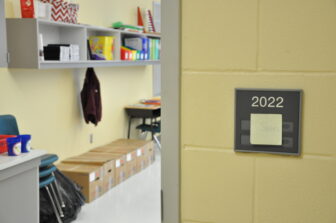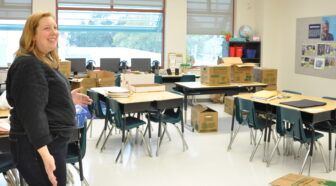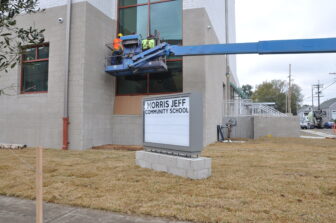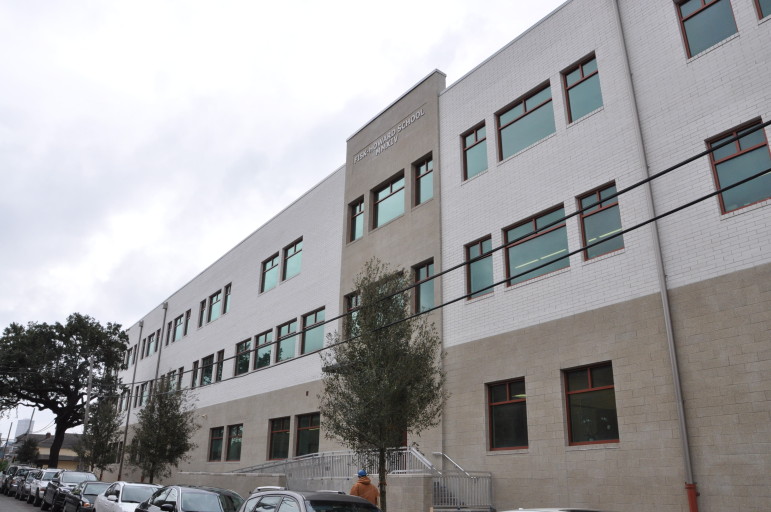A yellow sticky note with the word “Sears” scribbled on it labeled veteran teacher Erin Sears’ new classroom.

“Welcome to my room!” she beamed at the doorway, welcoming her fellow second-grade teachers.
Sears and about 80 other Morris Jeff Community School staff were taking a first look at their new school the week before winter break.
After its move over the holidays, Morris Jeff is continuing to settle into one of 10 either new or completely renovated schools slated to be ready for New Orleans public school students in 2015. More than 10 additional multi-million-dollar school projects are underway that will be completed in 2016 or later. All are part of a $1.8 billion investment of federal money to rebuild the city’s schools after Hurricane Katrina.
Morris Jeff’s 400 students had an extra week of winter break this year so teachers could pack, move and set up classrooms inside the new building in Mid-City.
Teachers carried in curriculum material alongside construction workers carrying tiny wooden playset stoves destined for kindergarten classrooms.
The staff’s excitement was easy to spot with ear-to-ear grins at every corner and doorway, and exclamations over seemingly minute details, such as “appropriately sized” chairs and having sinks in classrooms.
They set up desks while workers laid sod, poured concrete and put the finishing touches on the long-awaited school.

Morris Jeff, which incorporates the International Baccalaureate curriculum, opened during the 2010-11 school year. This is the school’s third move in its five years.
But this time, things are different — it’s a permanent home.
“We just shed our tears upstairs when we were talking about what a wonderful opportunity it is for children in New Orleans, who traditionally have not had very good facilities, to really have an opportunity to work and go to school everyday in such a beautiful place,” Principal Patricia Perkins said, sitting in her yet-to-be-decorated office.
“We have, on our faculty, quite a few veteran teachers who taught in some of those crumbling conditions,” Perkins said. “So they recall very clearly how hard it was, and how unfair it was, for our children to have to go to school in those circumstances.”
In 1995, voters approved a $175 million renovation program for New Orleans’ dilapidated schools. This December voters reauthorized the tax for an additional 10 years, an estimated $15 million each year, to help pay for maintaining facilities.
That money will fund both Recovery School District and Orleans Parish School Board controlled facilities. Morris Jeff is a kindergarten-through-fifth-grade Recovery School District charter.

Workers unveiled the elementary school’s new illuminated lawn sign recently, reading “Morris Jeff Community School.” That’s a different name than the letters affixed to the top of the building spell out — Fisk-Howard School — but that’s not uncommon in New Orleans where young charter schools occupy long-standing buildings. For the past few years, it’s been a school shuffle, where charters move from building to building on their way to a permanent home, should they keep their charter long enough to receive one. And that citywide trading of campuses isn’t likely to stop soon.
In fact, there’s already a charter lined up to take Morris Jeff’s most recent home in an old Catholic elementary school, near Bayou St. John. Sears said the bayou was a great resource for science and other sensory lessons. She spent quite a bit of time there with students.
“I took my class out on Friday and we said bye to the bayou,” Sears said.
One student asked if she would still be his teacher with the same classmates when they returned after break. Of course, she reassured him. And that may be one of the benefits of moving mid-year: Students will have the stability of the same teachers and classmates to introduce them to the campus.
The first week of school in January in the new building was like the first week of the school year. The children had to learn the basics: layout of the building, where the bathrooms are, where they sit in the cafeteria and various other school rules.
The school held an open house Jan. 5 to familiarize parents and students with the new building, and students started classes the next day.
“There are some families that we have who have been dreaming of this for years,” Sears said. “This isn’t just the teachers … it’s the dream of a neighborhood, a community and a city.”
A new school-zone sign on South Rendon Street lists the correct times, changed in 2012, for drivers to slow down. A sign on Palmyra Street has the old times, remnants of a school occupied pre-Katrina.
The original school, and its city block, sat empty for years after the hurricane. First as an old shadowy brick school, whose parking lot served as higher ground respite for neighbors during storms that flooded the surrounding streets. Once the school had been torn down, the grass lot hosted a makeshift football field or dog park, whatever was the pleasure of the people who lived nearby.
Then, neighbors endured months of house-rattling pile-driving, and years of construction noise and muddy streets. Despite the annoyances, neighbors were willing to compromise on the number of parking spaces required — meaning more cars parked on the street — so Morris Jeff could have a larger school yard.
Sears was excited to introduce families to the building. She’s also excited about the little things.
Like having a thermostat she can control. And the boys and girls bathrooms being next to each other. Not only will that be a time saver, she said, but it will help her more easily keep track of students.
For the first lesson back, the class studied outer space.
“This roof is going to be our moonscape and those are like our Mars rovers,” Sears said, looking out at mechanical equipment on the first-story roof visible from her second-story classroom.
Having a beautiful place to learn, Sears said, goes a long way toward showing children that learning is valuable and that our society thinks education is important.



